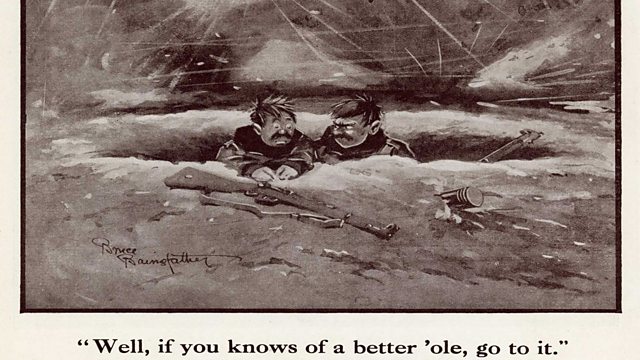Sutton Veny, Wiltshire: Comic Relief for the Empire in its Darkest Hour
The WW1 cartoon which would become known around the world
“Well, if you knows of a better ‘ole – go to it…”
These are the words of a cartoon drawn during WW1 which connected so truthfully with the resigned humour of soldiers in the trenches that it became a catchphrase used by world leaders as well as the general public.
The cartoon is a simple one, which is perhaps why its humour still rings true today. Two bareheaded soldiers, up to their chests in a shell hole, bleakly survey the grim moonscape of the battlefield around them. Nearby, an unexploded shell is seen; its nose threateningly buried in the mud.
One looks to the other and utters the now famous phlegmatic line.
The “Better ‘Ole” cartoon, as it’s become known, was drawn in Wiltshire in 1915, at Greenhills, now a nursing home in Sutton Veny.
The original drawing has survived, and on the reverse has the address "34th Div HQ, Greenhill, Sutton Veny" written in Bairnsfather's handwriting.
Its significance as a cartoon, and as a universally accepted comic reference, is well-known.
Mark Warby has researched Bairnsfather’s work. He says that Bairnsfather joined the army at the outbreak of war and was sent to France as a second-lieutenant in the Royal Warwickshire Regiment. In the trenches of Flanders, as a form of amusement to cheer his comrades, he would draw cartoons of a sort on the walls of a farmhouse or sketch his thoughts on scraps of paper and pass them along the trench. From these beginnings came the characters of Old Bill, Bert and Alf and the Fragments From France.
Old Bill was Bairnsfather’s most well-known, iconic, character and would appear regularly in his work, under the banner title, “Fragments from France”.
His first published cartoon appeared in The Bystander magazine in March 1915, after he’d speculatively submitted it thinking it ‘was in their line’.
Having been wounded serving with the Warwicks; Bairnsfather was attached to the 34th Division from September 1915 until January 1916. He was based at Sutton Veny near Warminster, as a machine gun instructor.
By this time Bairnsfather's name was well-known. During the few months he was stationed at Sutton Veny he would have completed many original 'Fragments from France' for publication. Among these was his most famous, “better ‘ole” cartoon, published in The Bystander on 24 November 1915. The cartoon was incredibly popular when published, and since then Bairnsfather's caption has been 'borrowed' by other cartoonists and political figures.
Bill Tidy is a celebrated modern day cartoonist. He says that Bairnsfather had a rare talent in humorously portraying universal suffering: “The acceptance of awfulness, I think, is what comes to soldiers after a while. None of Bairnsfather’s work is condescending. This is the way people spoke and this is the way they acted. He [Bairnsfather] knows when to drop an ‘h’ and it works; it stands the test of time.”
The cartoonist wrote about his time at Sutton Veny in his second autobiographical work, "From Mud to Mufti" - published in 1919, which recounts his career in the war from 1915 through to the Armistice. Extracts from two illustrated letters written by him at Sutton Veny were also published in another book about him, in 1916.
Location: Sutton Veny, Wiltshire
Image: Bruce Bairnfather’s cartoon courtesy of Mark Warby of www.brucebairnsfather.org.uk
Duration:
This clip is from
Featured in...
![]()
Arts & Media
The impact on arts, literature, poetry and journalism
![]()
����ý Wiltshire—World War One At Home
Places in Wiltshire that tell a story of World War One
More clips from World War One At Home
-
![]()
The loss of HMY Iolaire
Duration: 18:52
-
![]()
Scotland, Slamannan and the Argylls
Duration: 07:55
-
![]()
Scotland Museum of Edinburgh mourning dress
Duration: 06:17
-
![]()
Scotland Montrose 'GI Brides'
Duration: 06:41








